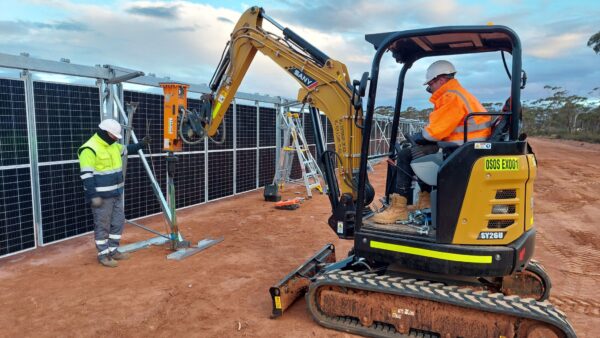Cambridge Energy said the first Australian deployment of its Nomad system – that combines solar tracking technology in a prefabricated and modular design – has now been completed at Norton Gold Fields’ Binduli mining operation near Kalgoorlie in Western Australia’s Eastern Goldfields region.
“We were thrilled to have hosted site visits last week showcasing our newly completed Norton Binduli 2.3 MWp Nomad project,” the company said.
“The success of this deployment was a proud achievement for us, and for the renewable energy landscape, demonstrating the huge potential for ultra-low cost solar here in Australia.”
“We now have firm proof of how the Nomad outperforms other technologies in the region and that prefabricated solar tracking will enable the next big leap.”

Image: Cambridge Energy
Cambridge, which delivered the project for Perth-based energy and mining consultancy ResourcesWA and investment firm CrossBoundary, said its Nomad system is the only PV solution in the world that combines prefabrication with solar tracking, setting “a new standard in delivering efficient, cost-effective, and sustainable solar.”
“The technology revolutionises solar energy by offering the benefits of solar tracking in a unique, prefabricated design,” the company said. “It maximises energy yield, making solar projects more feasible, cost-effective, and socially responsible.”
Cambridge which was founded by Australian Tom Miller, said the Nomad system features bifacial panels mounted on a single-axis tracking system which allows for maximum energy output, claiming the Nomad generates 45-50% greater yield than other prefabricated solutions.
The system also features an innovative anchoring solution that eliminates the need for piles and concrete. The tracker is anchored to the ground using percussion-driven earth anchors that utilise the soil as a counterweight and are connected to the structure through cables.
“This anchoring method eliminates the need for extensive groundworks, steel piles or concrete, and ensures minimal disruption to the soil during installation and decommissioning,” Cambridge said.

Image: Cambridge Energy
The system has been designed to be stored in a shipping container, and Cambridge said it can be removed and reinstalled as and when required with the modular design reducing inefficiencies in transport and installation, while making for faster deployment than conventional solar, resulting in lower deployment costs.
Trent Colyer, managing director of Perth-based OSOS Global Services which provided the installation team behind the 2.3 MW Binduli project, said the install had gone much quicker than expected.
“We had never installed one of these Cambridge models before, and no one in Australia has either. But they’ve made it very, very simple for us to do it,” he said.
Colyer said the small installation crew had deployed 1 MW per week using regular construction machinery.
This content is protected by copyright and may not be reused. If you want to cooperate with us and would like to reuse some of our content, please contact: editors@pv-magazine.com.









First solar quantum dot solar modules are quite interesting and it is going to rule the world in coming days… iam in solar industry since 3 decades.. I am interested to have a possible tie-up in this new technology..